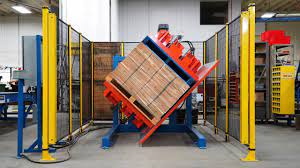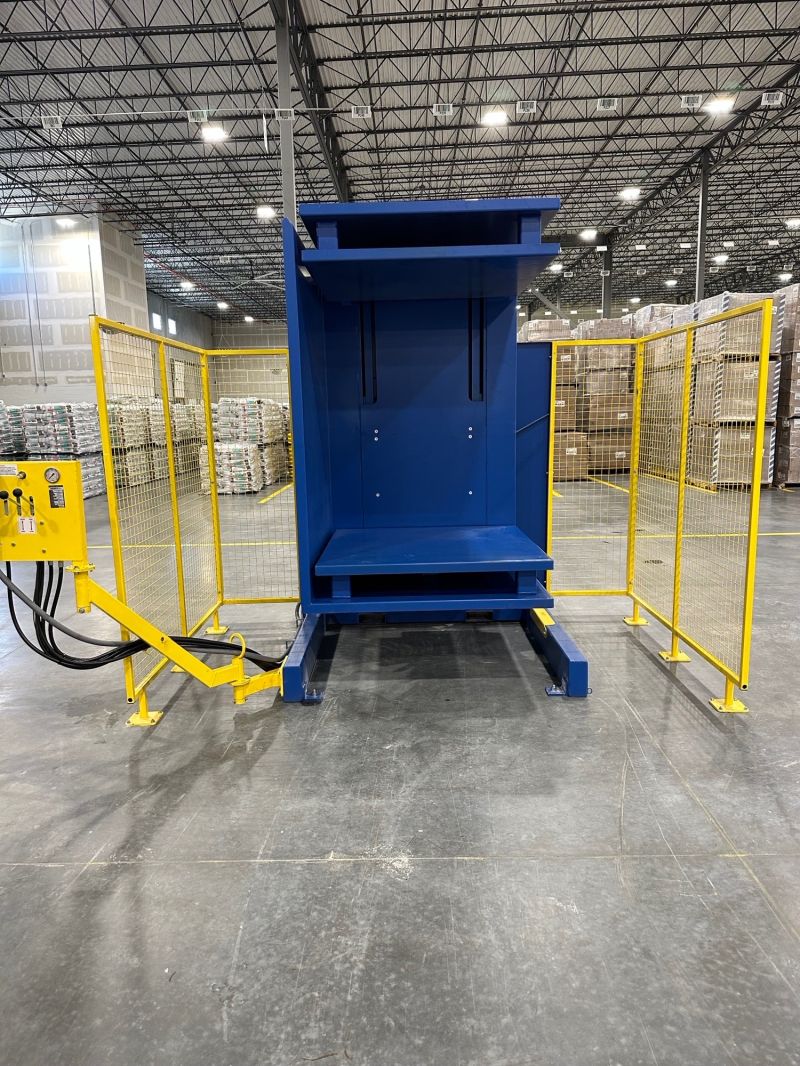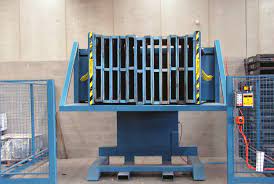Why Are United Kingdom's Manufacturers Replacing Manual Handling with Pallet Inverters?
Are you a manufacturer in the United Kingdom? Then you know the pressure is on. You face rising labour costs, a shortage of skilled workers, and incredibly strict safety rules from the Health and Safety Executive (HSE). Every day, your team manually handles heavy pallets. This is slow. It's risky. And it creates bottlenecks in your production line. You are constantly worried about a worker getting injured, a valuable shipment being damaged, or a simple handling task causing a major delay. These small problems add up, eating away at your profits and your peace of mind. But there is a better way. That's why smart manufacturers across the UK are now looking at proven technology to solve these problems. Pallet inverters are becoming a critical tool, changing the game for how materials are handled.
United Kingdom's manufacturers are replacing manual handling with pallet inverters to significantly boost operational efficiency, improve worker safety to meet HSE standards, cut down on product damage, and reduce direct labour costs. This technology allows for faster, more reliable, and safer load transfers, making their operations more competitive.

This shift is not just about buying a new machine. It is a strategic choice that affects your entire business, from your financial performance to your factory's ability to adapt to future demands. It's about building a more resilient and efficient operation. Let's look closely at why this change is happening and how a pallet inverter can transform your factory floor.
How Do Pallet Inverters Directly Address UK's Rising Labour Costs and Safety Regulations?
Your wage expenses are going up every year. Finding good, dependable people for manual jobs is getting harder. At the same time, the HSE's rules on manual handling are not just guidelines. They are legal requirements. A single violation can lead to heavy fines and damage to your company's reputation. Manual pallet handling is a major source of risk for both of these challenges.
Think about this for a moment. Every time your team manually transfers a load from one pallet to another, you are not just paying for their time. You are also accepting the risk of a serious back injury. A single workplace injury claim in the UK can cost tens of thousands of pounds, not to mention the lost productivity and the negative impact on team morale. It feels like you are walking a tightrope, trying to balance costs and safety. This is a constant source of stress for any factory owner.
Pallet inverters provide a clear and direct solution. They automate the difficult and dangerous work of lifting, turning, or transferring a full pallet load. This removes the physical strain from your employees. It also creates a standardized, safe process that fully complies with the UK's tough safety laws. It is a single solution to two of your biggest problems.
Pallet inverters directly solve the problem of rising UK labour costs by reducing the number of people needed for manual handling tasks. This lets you move your valuable employees to more important jobs. They also ensure compliance with Health and Safety Executive (HSE) rules by eliminating the dangerous lifting and twisting that causes most workplace injuries.

A Deeper Look at Cost and Compliance
When I started my own factory, I learned that the cost of an employee is much more than their salary. You have costs for recruitment, training, and personal protective equipment (PPE). But the biggest hidden cost is workplace injuries. I remember working with a client in the steel industry. His situation was very similar to many owners I meet today. He was dealing with an aging workforce and rising injury rates on his steel wire packing line. In one year, they had two serious injuries from manually handling heavy wire coils. The HSE investigation was stressful and expensive. The fines were a huge wake-up call for him. That's when we started talking about automation, not as a luxury, but as a necessity.
A pallet inverter transforms this high-risk task into a safe, one-person operation. The operator simply places the pallet in the machine using a forklift and pushes a button. The machine does all the heavy work. This engineering solution is exactly what the HSE wants to see. It removes the hazard at the source, which is far more effective than just providing more training.
Let's compare the two methods directly.
Manual Handling vs. Pallet Inverter: A Clear Comparison
| Feature | Manual Handling | Pallet Inverter |
|---|---|---|
| Labour Requirement | 2-4 operators | 1 operator (supervisory) |
| Risk of Injury (MSDs) | High | Negligible |
| HSE Compliance | High risk, needs constant oversight | Low risk, engineered solution |
| Cost per Pallet Transfer | High and variable (wages, claims) | Low and fixed (energy, maintenance) |
| Process Speed | Slow, inconsistent | Fast, consistent (< 60 seconds) |
| Product Damage Risk | Moderate to High | Very Low |
This isn't just about cutting costs. In the current UK labour market, showing that you invest in your employees' safety makes you a more attractive employer. It helps you keep your best people. A pallet inverter sends a clear message: we value our team's well-being and we are a modern, forward-thinking company. For a pragmatic business owner, this is a powerful benefit that supports long-term stability and growth.
What Are the Hidden Operational Inefficiencies of Manual Pallet Handling in Modern UK Factories?
You believe your factory is running efficiently. But small, hidden delays can add up to huge losses. Manual pallet handling is one of these hidden problems. It might seem "good enough," but it often acts as a brake on your entire operation, quietly slowing everything down.
A team might take a few extra minutes to manually restack a pallet. It doesn't seem like a big deal. But think about how many pallets you handle every single day. Multiply that lost time by hundreds of pallets, and you are losing countless hours of productive time each year. This creates queues for your stretch wrapper. It causes delays at the loading bay. It disrupts the production schedules you worked so hard to create. This is how small inefficiencies slowly kill your productivity.
A pallet inverter solves this problem by making the process predictable. It replaces a variable, manual task with a standardized, automated one. It creates a smooth and fast flow of goods through your factory, removing the bottlenecks you didn't even know you had. This is how you achieve the kind of operational excellence that defines a modern UK factory.
The hidden inefficiencies of manual pallet handling are significant. They include inconsistent and slow cycle times, a higher rate of product damage from mishandling, production bottlenecks that disrupt your workflow, and the wasted floor space needed for manual restacking. Together, these issues lower your factory's total output and drive up your operating costs.

Diving Deeper into Operational Flow
For a business leader like yourself, achieving high capacity utilization is a top goal. You want your machines running, not waiting. Manual handling is the enemy of predictable scheduling. One day, a pallet transfer might take five minutes. The next day, with a different team or a more difficult load, it might take fifteen. You cannot build a reliable production schedule on such an inconsistent process.
The True Cost of Product Damage
I learned this lesson the hard way in my early days. We were handling heavy steel coils, and before we automated the process, damage was a constant problem. A dropped coil meant a scratched surface, which often meant the entire coil had to be scrapped or sold at a discount. It was a huge source of waste. When we introduced mechanical tippers and inverters, the damage rate dropped to almost zero overnight. The savings from preventing product damage alone were enormous. A pallet inverter protects your products. Whether you are handling bags of cement, boxes of food, or sensitive electronics, the gentle and controlled motion of an inverter prevents the crushing, dropping, and shifting that is common with manual handling.
Maintaining the Production Rhythm
Think of your production line like a relay race. Each station must pass the baton to the next one smoothly. Manual pallet handling is like a runner who sometimes trips. When a pallet transfer is delayed, it doesn't just stop that one task. It starves the next machine in the line, like your pallet wrapper. Or, it causes a traffic jam at the loading dock, delaying shipments. This breaks the entire "flow" of your operation. An automated pallet inverter acts as a reliable runner in the race. It performs its task in a fixed amount of time, every time. This allows you to synchronize your entire production line. It helps you achieve the kind of smooth, continuous flow that lean manufacturing is all about. This is especially critical when you need to switch pallet types, for example, moving goods from a standard wooden pallet to a plastic hygiene pallet for a food-grade or pharmaceutical area. A pallet inverter makes this transition seamless and fast.
Can a Pallet Inverter Integrate with Existing Automated Systems for a Digital Transformation?
You are making smart investments in your factory's future. You are adding automated conveyors, Automatic Guided Vehicles (AGVs), and a Manufacturing Execution System (MES) to track everything. But you might have "islands of automation" that are not connected. They are separated by old, manual processes. This gap breaks your data flow and stops you from getting the full benefit of your digital transformation.
Imagine this scenario. Your brand-new, high-speed stretch wrapper is sitting idle. It is waiting for a pallet that is being slowly and manually restacked. Your expensive MES software shows that an order is ready to ship, but the physical product is stuck in a manual handling queue. This gap between your digital plan and the physical reality on your factory floor is where smart factory projects fail. It is a source of major frustration and wasted investment.
Modern pallet inverters are designed to solve this exact problem. They are not just standalone machines anymore. They are built to be smart, connected parts of a fully automated production line. They can communicate with your other systems, bridging the gap and creating a truly seamless, automated workflow.
Yes, a modern pallet inverter can and should integrate with your existing automated systems. They are engineered to connect with conveyors, AGVs, and your central MES. This makes the pallet inverter a key part of your automated production line and a powerful tool for achieving your company's digital transformation goals.

From a Standalone Machine to a Connected Asset
For a forward-thinking leader who is focused on digitalization, this is the most exciting part. A pallet inverter is no longer just a piece of mechanical equipment. It is an intelligent asset. It has its own brain—a Programmable Logic Controller (PLC)—that allows it to talk to other machines. This is the key to true automation.
The Power of PLC and MES Integration
Here is how it works in a smart factory. Your MES, the central command system, identifies a pallet of goods that needs its pallet changed, maybe to switch from an in-house pallet to a cheaper export pallet.
- The MES sends a command to an AGV to pick up the pallet and transport it to the pallet inverter.
- Sensors on the inverter confirm that the pallet has arrived.
- The inverter automatically performs the transfer cycle.
- Once finished, the inverter sends a "task complete" signal back to the MES.
- The MES then directs the AGV to take the newly palletized load to the next station, such as the shipping bay.
This entire process happens without any human intervention. It is fast, error-free, and fully documented in your system. This level of integration is what turns a group of machines into a single, intelligent system. It is how you achieve the kind of efficiency and control needed to compete in today's market.
Enabling Data-Driven Decisions
This integration also provides valuable data. A connected pallet inverter can report its status back to your central system. It can tell you how many cycles it has run, how long each cycle took, and if it is experiencing any issues. This data is gold. You can feed it into your analytics platform to monitor performance and, more importantly, to enable predictive maintenance. Your system could alert you that a component is nearing the end of its life before it fails. This allows you to schedule maintenance during planned downtime, instead of having an unexpected breakdown halt your entire production line. This directly supports your goal of maximizing uptime and operational stability. As a partner, this is the kind of total solution we at SHJLPACK help our clients build.
What is the Real Return on Investment (ROI) for a Pallet Inverter Beyond Simple Labour Savings?
When you look at the price of a pallet inverter, it's natural to focus on the initial cost. It is easy to calculate how much you will save on wages. But if you stop there, the numbers might not seem compelling enough. You might miss the much bigger picture.
If you only focus on labour savings, you might decide against an investment that could fundamentally improve your entire operation. You would be ignoring all the other hidden costs that are currently hurting your business. Think about the cost of products damaged during manual handling. Think about the production downtime caused by bottlenecks. Think about the financial risk of a major safety violation. These costs are real, and they are eating into your profits every single day.
A proper Return on Investment (ROI) analysis for a pallet inverter must look beyond the obvious. It has to consider the total impact on your business. This includes the tangible savings you can easily measure, but also the powerful, indirect benefits like improved production flow, higher employee morale, and a stronger reputation in the UK market.
The true ROI for a pallet inverter goes far beyond just saving on labour. The biggest returns come from eliminating the cost of product damage, increasing your factory's throughput, lowering your insurance premiums through better safety, and gaining the flexibility to use cheaper pallets for shipping while keeping your expensive ones in-house.

A Comprehensive ROI Breakdown
As an engineer and a factory owner, I always look at the numbers. An investment must make financial sense. Let's break down the true ROI of a pallet inverter for a pragmatic business leader like you. I encourage my clients to look at these four areas.
1. Direct, Tangible Savings
- Reduced Labour Costs: This is the most obvious one. You can redeploy 1-3 employees from a manual handling team to more value-added work.
- Elimination of Product Damage: This is huge. I worked with a client in the food and beverage sector. We calculated that just a 0.5% product damage rate on their output was costing them over £80,000 per year. The pallet inverter cost less than that. It paid for itself in under a year on this metric alone. You need to calculate this number for your own operation.
- Lower Insurance Premiums: A safer workplace with fewer injury claims leads to lower premiums for your employer's liability insurance. Your insurer will see the pallet inverter as a major risk reduction.
- Pallet Fleet Optimization: This is a smart strategy. You can keep your high-quality, expensive pallets for internal use within your factory and use a pallet inverter to switch loads to cheaper, one-way export pallets for shipping. The savings can add up to thousands of pounds a month.
2. Indirect Gains and Strategic Advantages
- Increased Throughput and Capacity: By eliminating bottlenecks, the inverter allows your entire line to run faster. This means you can produce more with the same equipment and people. This directly addresses the goal of increasing capacity utilization.
- Improved Production Predictability: A consistent cycle time allows for better planning and scheduling, which is the foundation of an efficient operation.
- Enhanced Worker Safety and Morale: Investing in safety shows your employees you care. This improves morale, reduces staff turnover, and makes you a preferred employer in a competitive UK job market.
- Strengthened Brand Reputation: Being known as a safe, modern, and efficient manufacturer is a powerful asset. It gives your customers confidence and helps you win new business.
When you add all of these factors together, the business case for a pallet inverter becomes undeniable. It's not an expense; it's an investment in a more profitable, stable, and future-proof operation. This is the kind of strategic thinking that separates market leaders from the rest.
Conclusion
Replacing manual handling with pallet inverters is a critical strategic move for UK manufacturers. It boosts safety, efficiency, and future-readiness, delivering a powerful return on investment beyond just savings.




